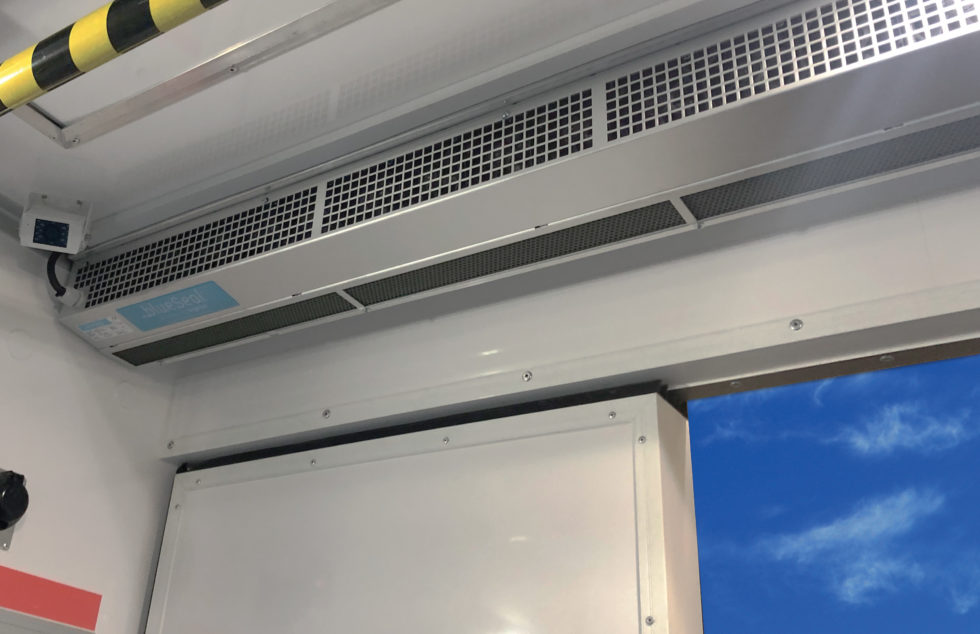
BlueSeal – Air Curtains for Energy Efficient Vehicles: Helping Electric Refrigerated HGVs Go the Extra Mile by Preventing Energy Loss
This year has seen huge leaps forward in the development of refrigerated fully electric HGVs, as viable options have started to enter the market and meet commercial demands. With conversations centering around longer battery life and lighter vehicles, Brightec asks whether enough is being done to control energy loss during deliveries when doors are opened.
The Role of Air Curtains for Energy Efficient Vehicles
BlueSeal air curtains were originally developed to control energy loss at the most crucial stage of the cold chain during early eutectic refrigeration system trials. They offered a zero-emission solution for transporting goods, focusing on the leading cause of energy loss – door openings.
By identifying this weak point, BlueSeal was designed to manage heat transfer in the most energy-efficient and non-intrusive way possible, allowing drivers to maintain climate control without compromising delivery efficiency.
Why Electric Vehicles Still Lose Energy During Deliveries
Modern refrigerated vehicles are highly adept at preserving cold air during transit thanks to advanced insulation and improved airflow systems. However, these benefits disappear the moment doors are opened during loading and unloading.
Brightec founder, Dr Hans Opdam, explains: “If your fridge door is left open, you’d be shocked at your energy bill and the spoilage. Refrigerated transport is no different – the only way this technology will be used to its full potential is by managing infiltration heat loads effectively.”

How BlueSeal Air Curtains Reduce Refrigeration Energy Loss
BlueSeal provides a precisely engineered laminar airflow that acts as a barrier between inside and outside temperatures. Contrary to common belief, higher airspeed is not always better – it can actually draw in surrounding warm air. BlueSeal’s performance is the result of decades of fine-tuned research by physicists to achieve optimal energy efficiency.
Energy Savings: The Impact of Air Curtains for Energy Efficient Vehicles
Brightec’s simulations revealed that without temperature control at door openings, cooling energy use can increase by 3 to 5.5 times during distribution runs. For diesel vehicles, this translates to hundreds or even thousands of litres of extra fuel annually.
In electric vehicles, where battery capacity is limited, this wasted energy directly reduces refrigeration uptime – a critical factor for operators transitioning to zero-emission fleets.
BlueControl: Smart Energy Management for Electric Vehicles
Integrated into BlueSeal, the BlueControl unit helps preserve EV battery life by encouraging stricter door-closure habits. It can:
- Alert drivers when doors remain open too long
- Shut off automatically when battery levels are low
- Integrate with sensors to detect door status in real time
This ensures air curtains operate only when needed, maximising efficiency.
BlueSmart: The Next Step in Air Curtains for Energy Efficient Vehicles
In 2025, BlueSeal will launch BlueSmart, an advanced climate control device for vehicles. By regulating airflow based on temperature differences and environmental factors, BlueSmart ensures the air curtain runs at peak efficiency, further extending battery range and reducing operational costs.
In summary: As electric refrigerated transport grows, air curtains for energy efficient vehicles like BlueSeal are becoming essential. By preventing costly energy loss at the loading dock, they help operators go farther, save more, and support the transition to zero-emission logistics.
For more information on BlueSeal air curtains, please contact our Brightec consultants at [email protected]